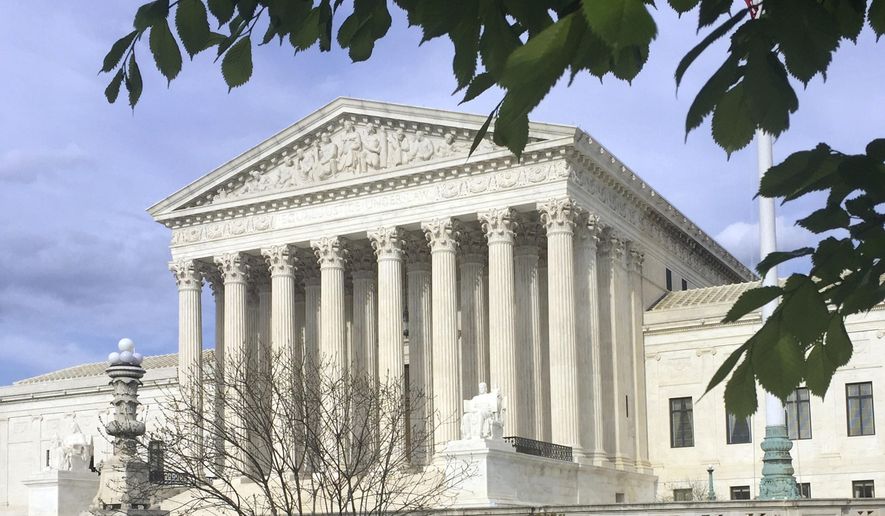The Supreme Court declined Monday to overturn Wisconsin’s heavily gerrymandered legislative districts, saying the plaintiffs didn’t do enough to prove they had standing to bring the lawsuit.
The decision amounts to a punt on one of the most closely watched cases of the year, leaving for another day the big questions of how much partisanship is allowed when legislatures draw their maps.
Chief Justice John G. Roberts Jr., writing for the court, said it wasn’t enough to claim that Wisconsin’s districts were drawn to favor one party or another. The plaintiffs needed to prove they individually were unable to vote for a credible candidate of their choice because of the gerrymander.
“It is a case about group political interests, not individual legal rights. But this court is not responsible for vindicating generalized partisan preferences,” Justice Roberts wrote.
Justices sent the case back to the lower courts to give the plaintiffs another chance to make their argument — an unusual move.
While all of the justices agreed this case wasn’t ready for the high court, the court’s liberal wing signed an opinion saying they’re ready to step in and curtail gerrymandering when the right case does arise.
“Of one thing we may unfortunately be sure. Courts — and in particular this court — will again be called on to redress extreme partisan gerrymanders. I am hopeful we will then step up to our responsibility to vindicate the Constitution against a contrary law,” wrote Justice Elena Kagan, in an opinion signed by Justices Ruth Bader Ginsburg, Stephen G. Breyer and Sonia Sotomayor.
Justice Anthony M. Kennedy did not sign that concurring opinion. He’s considered the key swing vote for when the courts eventually do find a political gerrymander case they’re ready to rule on, and his silence will leave court-watchers confounded.
Gerrymandering — the practice of drawing legislative lines to favor one party or candidate over another — has existed since the early days of the country. People are included in one district or another because there presence could either boost or hinder a candidate the legislature is trying to favor.
The courts have ruled the practice unconstitutional when the goal is to prevent a minority candidate from winning, but the Supreme Court has never explicitly ruled against partisan gerrymanders — those done to boost one party’s prospects.
Wisconsin’s maps were considered among the most gerrymandered in the country when they were redrawn after the 2010 census.
The plaintiffs in Monday’s case said Wisconsin lawmakers “packed” Democratic voters into certain districts while spreading Republicans around the other districts to ensure more GOP wins.
That led to a situation in 2012 where only 49 percent of voters cast ballots in the state Assembly for Republicans, yet the GOP won 60 of the 99 seats.
Part of the courts’ problem in grappling with political gerrymanders is it’s not always clear what’s going on, and what some people see as a gerrymander others see as a consequence of other factors such as keeping communities together.
The plaintiffs in Monday’s case urged the justices to adopt an “efficiency gap” measurement, which used statistics to calculate the number of “wasted votes” statewide. If a certain threshold was crossed, the map would be deemed an illegal gerrymander.
But the court ducked.
Jessica Levinson, a professor at Loyola Law School Los Angeles, said the ruling will narrow the number of people who can challenge maps.
“As a result, the court’s nondecision, decision on procedural grounds will allow the party controlling state legislatures to entrench their own power. This will likely harm voters, who are at the mercy of their lawmakers’ extreme partisan gerrymanders,” she said.
Civil liberties activists were frustrated — though they vowed to make the justices confront the issue again.
“While it’s disappointing to see the court punt, the decisions aren’t losses,” said Michael Li, senior counsel at Brennan Center for Justice.
He said the Supreme Court has another chance to weigh in on partisan gerrymandering next term on a case out of North Carolina, where a district court ruled the state’s congressional map was an unconstitutional partisan gerrymander.
Dale Ho, director of the American Civil Liberties Union’s Voting Rights Project, said there’s also a case developing in Ohio.
Republican voters in Maryland, meanwhile, have challenged their state’s congressional map, saying it was drawn to limit the GOP to winning just one of the state’s eight districts.
The court on Monday declined to side with the GOP voters, ruling that the lower court judge was correct to deny their request for an immediate halt to the state’s maps. The justices said the voters waited six years after the maps were drawn to challenge them, so there wasn’t the urgency to demand a preliminary injunction.
Joe Kanefield, an election law attorney in Arizona, said while state courts like Pennsylvania’s highest court have found partisan gerrymandering unconstitutional based on state law, it’s still at square one in terms of how federal courts can tackle the problem.
He said it is likely the Maryland and Wisconsin case returns to the justices before a new one makes its way to high court.
“They should be able to get enough plaintiffs with standing to bring a challenge in every district, which effectively would result in a statewide challenge,” he said.
• Stephen Dinan can be reached at sdinan@washingtontimes.com.
• Alex Swoyer can be reached at aswoyer@washingtontimes.com.




Please read our comment policy before commenting.